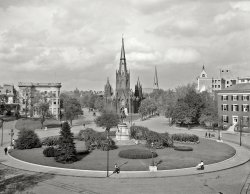
MAY CONTAIN NUTS

Search Shorpy
SHORPY ART

Framed or unframed, desk size to sofa size, printed by us in Arizona and Alabama since 2007. Explore now.
Join and Share
Ad-Free Shorpy
Shorpy is funded by you. Patreon contributors get an ad-free experience.
Learn more.

Recent comments
- Illuminate us
- I remember it well
- I can't prove it
- Complicated then, forgotten now
- Bryan-Stevenson
- Skinny is as skinny does
- How do you rest in peace
- Riding the footboards
- Alas, hidden from view
- Baldwin Diesels
- Exclusive pump
- Bananas, Oysters and Smokey Joe
- Details, Details
- What's that building to the left of the tower?
- Coal Barges
- Bromo-Seltzer
- Inner harbor
- The Basin
- What a headache!
- Giant stepladder?
- Yeah, it was cold
- Love those coats
- Link & Pin Days Remnant
- Baldwin 62303
- Baldwin VO-1000
- Cold
- No expense spared
- Tough Guys
- What's your hurry, where's your hat?
- Sheriff's Signature
Member Photos
The Shorpy
Print Emporium
Print Emporium
Search Shorpy
Search results -- 30 results per page
- Sid Caesar: 1922-2014
- ... Century" opposite Rock Hudson when it was playing in San Francisco in about 1979 or 1980. As manager of a local theatre production, I ... Posted by Dave - 02/12/2014 - 9:26pm -
![Sid Caesar: 1922-2014 Sid Caesar, Pioneer of Television Comedy, Is Dead at 91
A list of Mr. Caesar’s writers over the years reads like a comedy all-star team -- Mel Brooks, Woody Allen, Neil Simon, Carl Reiner, Larry Gelbart ... -- New York Times
New York, February 1952. "Your Show of Shows comedians Sid Caesar and Imogene Coca doing a skit about a couple watching 'The Continental'." From photos by Charlotte Brooks and Earl Theisen for the Look magazine assignment "Takeoff on 'The Continental'." View full size.
Uncomplicated TVThe Continental was an early 1950s TV show. The host, a European seductive type, invited women into his apartment for Champagne and and evening of pleasure, which included a movie. It lasted only one or two seasons. It was reincarnated on Saturday Night Live with Christopher Walken as the Continental. It was a lot funnier, but the 1950s show was, for its time, a bit risque, but tame by today's standards. Sid & Imogene's take on it must have been riotous at the time.
[Obscure fact I had to look up: The Continental was played by one Renzo Cesana. - Dave]
The cameraThat's a nice close-up of an RCA TK-10 camera. The knob and the hole at the lower left corner are not factory. Back then, studio engineers did a lot of actual engineering, making the equipment work better than new.
A true pioneer in television comedyUncle Miltie might have been first funnyman on the airwaves, but Sid took it to the next level.
His trusty sidekick went on to play Aunt Edna in the first 'Vacation' movie.
What a pair! Back when you had 3 channels to pick from, think of the percentage of American homes that were laughing along with them.
The Continental, SNL style....
First ShirleyAnd now Sid! It is strange how we seem to lose the greats in clusters of three! I wonder who will be soon to follow?
Live TV blooperOne night during his live broadcast, the Continental mixed up his nouns and supposedly said "the stockings do for your face what the powder does for your legs."
It's a Mad, Mad, Mad, Mad WorldWorth watching to catch all those wonderful comic actors doing their cameos. Caesar was a hoot, especially in the basement of the Hardware Store! He will be missed, thank goodness for YouTube and DVDs.
Grindl!I had the incredible pleasure of meeting Imogene Coca when she was appearing in "On the Twentieth Century" opposite Rock Hudson when it was playing in San Francisco in about 1979 or 1980. As manager of a local theatre production, I was able to go backstage on several occasions and chat with her. Once I told her that I should have asked her to autograph a program as "Grindl." She laughed, and said I was too young to remember that! But I actually remember her in Show of Shows, when everyone came over to our house to watch one of the only TVs in the neighborhood.
She was a delightful woman, and I miss her!
Rock Hudson, on the other hand, was brusque, and not really suited to the part he was playing on stage. The best performance I saw of that show (I saw MANY!) was with his stand-in.
(The Gallery, LOOK, TV)](https://www.shorpy.com/files/images/SHORPY_01619u.thumbnail.jpg)
- ROFL: 1955
- ... advantage of. Her birth records were destroyed in the San Francisco earthquake of 1906. When the 1900 census became public in 1972, her ... Posted by Dave - 06/17/2019 - 1:04pm -
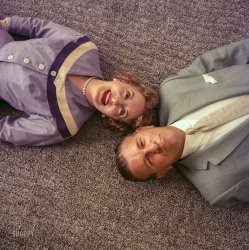
- Buying Time: 1925
- ... Introducing -- the Maxwell "Sisyphus Six"
San Francisco circa 1925. "Advertisement for the 'Good Maxwell,' built by Chrysler ... Posted by Dave - 02/01/2015 - 1:35pm -
![Buying Time: 1925 Introducing -- the Maxwell "Sisyphus Six"
San Francisco circa 1925. "Advertisement for the 'Good Maxwell,' built by Chrysler engineers." 5x7 glass negative by Christopher Helin. View full size.
Stuck?Problem with a lot of these old car photos is you can't tell if they are moving or not. This one might just be stuck and waiting for a tow.
I actually think that most if not all of them are still, not moving, because of the slow film speed.
[Photographic emulsions of the time were perfectly capable of stopping action, and long had been. This, however, is a posed promotional photo. -tterrace]
The Thirteenth ReasonIf it was good enough for Jack Benny, it's good enough for you!
To hear what his Maxwell sounded like, as interpreted by the great Mel Blanc, visit here:
www.youtube.com/watch?v=17N2g2Ryqi8
Yet another excellent title by DaveWell done, Dave. Kudos and accolades on your captioning acumen.
Reason # 13"Next year, the brand will be retired and you'll own an orphan car."
And now I shall try to imagine this Maxwell happy.
$25 cash prizeThe 13th reason for buying a good Maxwell is that it's better than buying a bad Maxwell.
(The Gallery, Cars, Trucks, Buses, Chris Helin)](https://www.shorpy.com/files/images/SHORPY-208-01A.thumbnail.jpg)
- Boys' Choir: 1942
- ... Collier co-founded the Visual Anthropology Department at San Francisco University and was teaching there in the 1970s.
(Boy Scouts, John ... Posted by Ken - 09/08/2011 - 11:38pm -
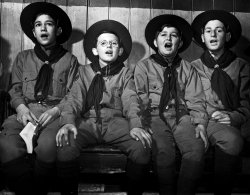
- Special Six: 1924
- San Francisco circa 1924. "Studebaker Special Six Duplex-Phaeton." Mother says to ... Posted by Dave - 05/29/2016 - 8:46pm -
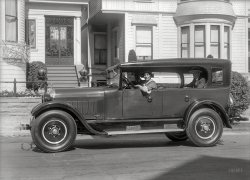
- Cafeteria Style: 1949
- ... image, and calling out Jack Delano! or Another of those San Francisco cars!) But there's the clinical recording in B & W of the ... Posted by Dave - 07/03/2015 - 3:47pm -
![Cafeteria Style: 1949 July 6, 1949. "Johns-Manville Research Laboratory, Finderne, New Jersey. Cafeteria. Shreve, Lamb & Harmon, architects." Continuing the tour begun here. Large-format acetate negative by Gottscho-Schleisner. View full size.
Gottscho-SchleisnerWhy do I love G-S so much? Part of it is the instant recognizability. (Although I do also love refreshing the site, seeing the new image, and calling out Jack Delano! or Another of those San Francisco cars!) But there's the clinical recording in B & W of the essence of a place, somewhere in or near NYC, sometimes of the amazing Manhattan skyline (e.g. Gotham Noir: 1933 or Midcentury Manhattan: 1950), at a time within living memory of some of us, and of objects and rooms and layouts which we younger oldsters recognize from our youths. G-S's clean photos also manage to exude a humanity and warmth, most of the time (all of the time?) without any humans present. Some of the images (e.g. 30 Rock: 1933 or Gotham: 1931) are so mythic and luminous that I wonder if they're actually photographs of real things.
Everything neat and tidy... and ashtrays properly placed. Kudos to the cafeteria crew.
Pardon MeThe above phrase had to be said anytime someone wanted to leave a table in the center or left sides of this room.
Hard Chairs ...... not designed for lingering.
[You don't see the rather thick seat cushions? The seatbacks are padded, also. -tterrace]
(The Gallery, Eateries & Bars, Gottscho-Schleisner)](https://www.shorpy.com/files/images/SHORPY-5a16073u1.thumbnail.jpg)
- Living the Dream: 1920s
- ... 15 years), my grandfather became a successful San Francisco real estate broker. This photo from the 1920s (exact date unknown) is ... to be 93 years old and passed away, alone, in 1976 in San Francisco, never having remarried. View full size.
(ShorpyBlog, ... Posted by Bob Burns - 02/09/2018 - 7:44pm -
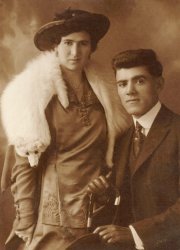
- Coast to Coast: 1924
- April 26, 1924. "Walking from San Francisco to New York for his health, W.E. Campbell stops at the White House. ... Posted by Dave - 06/07/2014 - 5:38pm -
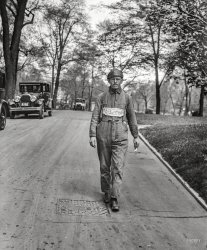
- Parlor Portrait: 1914
- San Francisco, 1914. My mother's family and their chandelier posed for a portrait ... Posted by tterrace - 12/03/2016 - 9:16pm -
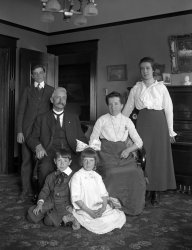
- F-86A California: 1954
- ... February 1952
To 6400th ADW FEAMCOM 27 April 1952
To San Francisco Air Materiel Command 7 June 1952
To Sacramento Air Materiel Area, ... Posted by dclark26 - 01/19/2011 - 10:07am -
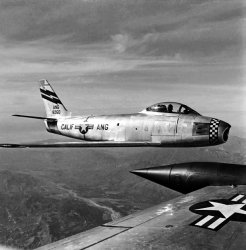
- Battle Stations: 1942
- ... Division,
Fleet Marine Force,
C/O Fleet Post Office, San Francisco, California.
I got it right here . . . Based upon the ... Posted by Dave - 05/06/2019 - 1:29pm -
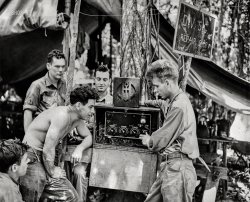
- Fountain of the Evening Star: 1940
- ... Golden Gate International Exposition, Treasure Island, San Francisco, 1940. The The woman with the hat at the Fountain of the Evening ... Posted by returntoBuddha - 05/15/2015 - 7:16pm -
![Fountain of the Evening Star: 1940 Golden Gate International Exposition, Treasure Island, San Francisco, 1940. The The woman with the hat at the Fountain of the Evening Star by sculptor Ettore Cadorin. From a box of Kodachrome slides I found at a flea market. View full size.
Early color photoMust be Kodachrome in its infancy!
[Actually the second version of the film, introduced in 1938. The original 1935 Kodachrome's color dyes were not as stable. -tterrace]
As a photographer......let me belatedly complement whoever took this picture on its excellent composition.
Treasure IslandI was stationed on Treasure Island for 10 days in July of 1969, while I was getting discharged from the Marine Corps. I was fascinated and mystified by the remains of streets and buildings laid out neatly over a large area, the only evidence being little stones in the ground marking off the blocks.
It was only many years later that I learned what it was all about. How I wish I had had a complete guidebook and map, to be able to visualize what had stood there! I'm told that even those little evidences are now long gone. :-(
(ShorpyBlog, Member Gallery)](https://www.shorpy.com/files/images/ggexpo1.thumbnail.jpg)
- Washstand Cowboy: 1939
- ... cabin, to rent at $400 per night to tourists from LA and San Francisco, flying in for a week to "slow down".
1939 must have been a year ... Posted by Dave - 01/23/2018 - 3:18pm -
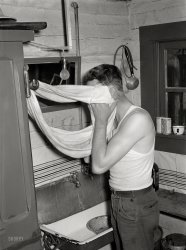
- Governor Pat Brown
- San Francisco, March 17, 1965. California Governor Edmund G. "Pat" Brown, Sr. , ... Posted by tterrace - 05/12/2016 - 3:12pm -
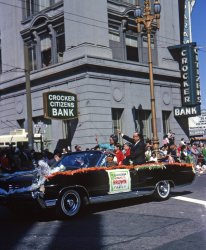
- Short Commute: 1943
- ... line well into the 90's. Apparently, some of those went to San Francisco's Market St. Railway when the Newark line became a modern light rail ... Posted by Dave - 09/26/2013 - 12:22pm -
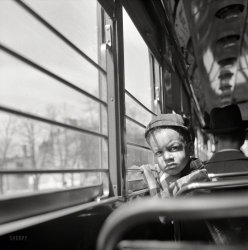
- Capital Steps: 1923
- ... flat (as they would be called in my home town, San Francisco, since they have private entrances from the street), probably has a ... Posted by Dave - 05/07/2013 - 5:13pm -
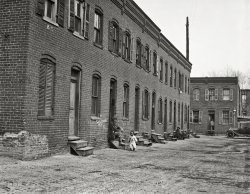
- Flower Lady: c. 1902
- ... size.
beautiful girl first glance I thought "San Francisco, 1967" She is sure gorgeous.
beautiful girl "be sure to wear ... Posted by Ken - 09/08/2011 - 11:45am -
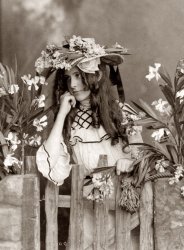
- Crossing Canal: 1890
- ... starting in 1893.
A few cities still have streetcars (San Francisco), but buses pretty much replaced them by the 1960s.
Individual ... Posted by Dave - 03/17/2019 - 9:47am -
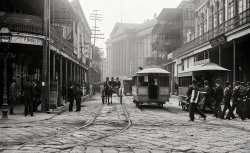
- Braking Point: 1932
- ... by California's governor and the mayors of Oakland and San Francisco."
Traffic Button Can someone explain the purpose of that ... Posted by Cazzorla - 05/11/2016 - 5:02pm -
![Braking Point: 1932 Los Angeles traffic cop/actor/chef Tom Jensen again, in the second photo of this exciting series, scanned by Shorpy member Cazzorla. View full size.
SnippetsAlthough the traffic cop is the same, along with the identical DeVaux automobile, the location is now at West 24th Street and South Vermont Avenue.
The Barber Shop and Beauty Shop sign at the upper right shows the address of the business run by Frank A. (1890 - 1950) and Gladys Whitaker at 2322 S. Vermont Avenue.
Norman deVaux, one of the DeVaux company founders, was friends with Governor James Rolph of California. The governor sought to publicize the California motor industry. Consequently there are several newspapers articles where the text states specifically that the governor was riding or driven in a DeVaux (which had a factory in Oakland).
In a feature on the DeVaux Automobile in the March-April 1972 "Antique Automobile" hobby publication, Richard Larrowe stated, "Fifty new 1931 DeVaux cars that had been made specially for the factory opening, paraded through the streets of Oakland, headed by California's governor and the mayors of Oakland and San Francisco."
Traffic ButtonCan someone explain the purpose of that traffic button on the pavement? I find it difficult to imagine its function. Thanks for any information.
[Check out the other photo linked in the caption. -tterrace]
Re: Google Street View TodayGoogle Street View today.
Meaning of Letters on License PlatesHealdsburg Tribune, Number 92, 20 February 1932:
What the letters mean on California motor vehicle licenses plates is a frequent question among motorists, observes the California State Automobile association, which gives the following explanation of the letter system.
....
Automobile dealers’ cars, of course, are easily recognized by the letters “DLR” on the license plates.
(ShorpyBlog, Member Gallery)](https://www.shorpy.com/files/images/IMG_0010.thumbnail.jpg)
- Dodge, c. 1949
- ... me was wandering around my father's grocery store in San Francisco, gleeful that I could just pull anything off the shelf, take it to ... Posted by duckpin - 09/20/2011 - 1:33am -
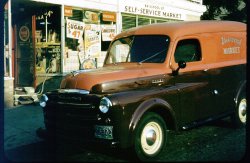
- Fly BOAC: c.1958
- ... many color slides that my father shot when we lived in the San Francisco area in the mid to late 1950's. This particular shot was taken on ... Posted by Rute Boye - 07/13/2012 - 10:37pm -
![Fly BOAC: c.1958 This is one of many color slides that my father shot when we lived in the San Francisco area in the mid to late 1950's. This particular shot was taken on Anscochrome film and shows Union Square in downtown SF. Note the overhead wires for the electric buses. I have many more like this, which I'll try to post as time allows. View full size.
A Corvette!Gimme that Vette, please!
Time LineThat 1958 Chevrolet looks like the newest car in the pic. This would make the earliest date fall of 1957. I don't remember that chrome piece at the rear of the back window.
[That bit of chrome was specific to certain Bel Air models. - tterrace]
A rare body styleThe Corvette is cool, but I'll take the '58 Bel-air hardtop. In fact, I had one almost exactly like it, bought it used in 1962 to go to college in. 1958 was a rare year for the entire GM lineup. The cars were new from the 55-57 group, but strangely not repeated in 59. The 58 models had another distinction––there were more available body styles than in 57 and previous years, or 59 and succeeding years. The one pictured here was a rare variation of the Bel-air 4-door hardtop. Most Bel-air 4-door hardtops had a slightly different treatment of the roofline and rear door pillars. This one is white over silver blue. Mine was silver blue over white, otherwise this car would be identical to mine. The car was a dreamboat and proved at college to be an incredible chick magnet. Co-eds loved to ride in it at night with the windows down, and my buddies and I loved to oblige them. BTW, the "V" emblem on the hood indicates a V8 engine, the soon to be famous "small block" Chevy. First year with 283 cubes, too. What a car!
B O A CAs our Brit friends explain it, "Better On A Camel"!
Thanks to DbellI sing with a community chorus, and we just wrapped up a concert series that was all music from the Beatles. Thanks to Dbell's pointing out the B.O.A.C. sign, I now have "Back in the U.S.S.R." stuck in my head - "Flew in from Miami Beach B.O.A.C...." Thanks for a great historic picture of one of my favorite cities!
(ShorpyBlog, Member Gallery)](https://www.shorpy.com/files/images/Union_Square_1.thumbnail.jpg)
- Wilmington Trolley Garage: 1950
- ... Wilmington. View full size.
Trolley Buses San Francisco Muni has an extensive fleet of trolley buses. Although the overhead ... Posted by jan_1968 - 09/19/2011 - 11:17pm -
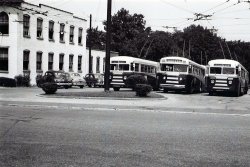
- Church Crew: 1902
- San Francisco c. 1902. Building St. Boniface Church. The monk in the center, ... Posted by tterrace - 04/03/2019 - 8:35am -
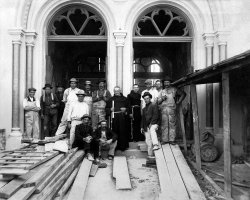
- Santa Monica: 1954
- ... this system being in use at many intersections in downtown San Francisco when, in the 1954ish period, I'd accompany my mother on shopping ... Posted by dclark26 - 12/14/2011 - 2:08pm -
![Santa Monica: 1954 This was tried for a few years. When it was time to walk everyone took off in any direction to get to the other side. Never did hear of the mortality rate with that new brainstorm. View full size.
ScrambleI remember this system being in use at many intersections in downtown San Francisco when, in the 1954ish period, I'd accompany my mother on shopping trips. It was called "scramble" then, and a quick search finds that it's still the term where it's in use. If you can believe Wikipedia, there are still a few in SF and and in some other US cities. The disadvantage isn't about pedestrian safety, as vehicles on both streets have a red, but in the potential increase in vehicular congestion.
Square dance It's being introduced here in Adelaide, South Australia as the 'Square Dance' intersection. I don't know if it's been used here before, certainly not since I started driving in the '70s.
It seems effective to protect those pedestrians that seem to get 'simpler' every year from the drivers who were 'simple' to begin with.
The Barnes DanceI remember doing this dance across the downtown streets of Baltimore in the early 50's. As matter of fact Mom could be pulling me across Lexington Street in this photo.
"Catty-cornered"This was the way my hometown traffic signals operated. People didn't wander aimlessly into intersections, however; there was always a tidy march either straight across the street or diagonally, which was called "catty-cornered." That's a term I haven't heard in years.
[It's a colloquialism for "catercornered." - Dave]
(ShorpyBlog, Member Gallery)](https://www.shorpy.com/files/images/3rd._and_Santa_Monica_Blvd._1954_Diagonal_Walking.thumbnail.jpg)
- City Hall: 1965
- San Francisco City Hall on March 14, 1965. I was with friends to take in the St. ... Posted by tterrace - 07/08/2019 - 10:17am -
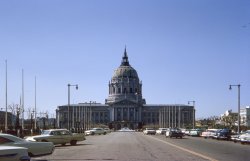
- Mme. Alda: 1909
- ... at the many world's fairs between 1893 (Chicago) and 1915 (San Francisco and San Diego).
The San Diego Museum of Art has in its collection ... Posted by Dave - 08/09/2012 - 11:43am -
![Mme. Alda: 1909 "Alda relaxing at home." The soprano Frances Alda in 1909, a year before she married Metropolitan Opera manager Giulio Gatti-Casazza. She was said to have "a temper as red as her hair." George Grantham Bain Collection. View full size.
Stunning KimonoThis appears to be ceremonial kimono, probably for a wedding. Oh, to have color! Very fashionable in this period but rarely so ornate (or nearly as expensive). Any experts out there who can tell us more?
[Used as a dressing gown, it would be for ceremonial lounging. - Dave]
Kyoto Silk KimonoThe beautifully embroidered peacock-in-a-garden kimono resembles Japanese wedding kimonos in its luxury, but was probably made specifically for export. During the late Meiji Period (1890s to 1912) much of this high-end embroidery, as well as silk tapestry panels with similar garden scenes, was made in Kyoto to supply the Western demand for beautiful "Oriental" textiles. Pictorial arrangements of exotic birds and flowers like that on Mme. Alda's kimono were derived by the Kyoto designers from 18th Century Chinese scroll paintings. Many of these robes and textiles were sold by Japanese importers at the many world's fairs between 1893 (Chicago) and 1915 (San Francisco and San Diego).
The San Diego Museum of Art has in its collection a very similar "peacock" kimono that was presented in 1910 as a state gift to the wife of an American diplomat. Unlike Mme. Alda's kimono, which is of white satin, the SDMA example was embroidered on pink creped silk, and definitely was used by the diplomat's wife as an "At Home" lounging robe in social rituals such as receiving her female friends for afternoon tea.
(The Gallery, Dogs, G.G. Bain, Portraits)](https://www.shorpy.com/files/images/01670u.thumbnail.jpg)
- Cuban Cargo: 1904
- Cuba circa 1904. "Muelle San Francisco, Havana." 8x10 inch dry plate glass negative, Detroit Publishing ... elevated tram line. It ran for 8 blocks over the Calle San Pedro. Below is a view from the other direction. I'd say the cases of Dietz ... Posted by Dave - 09/10/2013 - 11:40am -
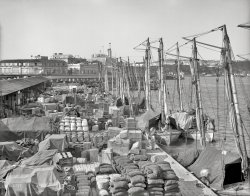
- New 737: 1969
- ... flight from Orange County Airport (now John Wayne?) to San Francisco in March 1969 in the just-introduced Boeing 737. This airline is long ... Posted by Islander800 - 12/14/2012 - 8:20pm -
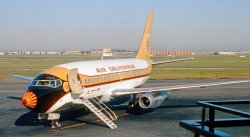
- Elmhurst Depot: 1899
- ... This picture reminds me so much of the St.Louis and San Francisco (StlSF) depot in my hometown of Columbus, Kansas. The milk cans were ... Posted by Dave - 04/26/2018 - 1:41pm -
![Elmhurst Depot: 1899 Elmhurst, Illinois, circa 1899. "Chicago & North Western Railway station." 8x10 inch dry plate glass negative, Detroit Photographic Company. View full size.
Wrong middle letterI'm thinking this is not the CNW station, which was a frame structure. Instead I believe it's the Chicago Great Western station (alternately the Chicago, Alton & Elgin), which was constructed of brick and was torn down sometime after 1960. (The CNW station survives, and is used by the Elgin parks department.)
[Incorrect. Searching eBay for "elmhurst postcard" would be a super-easy way to check. Click to enlarge. - Dave]
MemoriesThis picture reminds me so much of the St.Louis and San Francisco (StlSF) depot in my hometown of Columbus, Kansas. The milk cans were all on the freight platform ready to load when the train arrived plus any boxes or crates that needed shipped. In the spring, after the train had been, there might be crates of chicks cheeping that people had ordered from a supplier and other assorted boxes and crates that had been unloaded. With the steam, bell ringing, chuffing of the engine while it was in the station, and people debarking, It all seemed to be magic to me.
Elmhurst Depot: 2019Having been a resident of Elmhurst recently, I was moved to visit once more after seeing the 1899 photo above.. I tried to approximate the same position where the original photograph was shot here, 120 years later:
(The Gallery, Chicago, DPC, Railroads)](https://www.shorpy.com/files/images/SHORPY-4a04073a.thumbnail.jpg)
- Thomas Circle: 1906
- ... Grant, Sherman, Sheridan and Thomas. Died in 1870 in San Francisco.
(The Gallery, D.C., DPC) ... Posted by Dave - 05/08/2014 - 11:48am -
